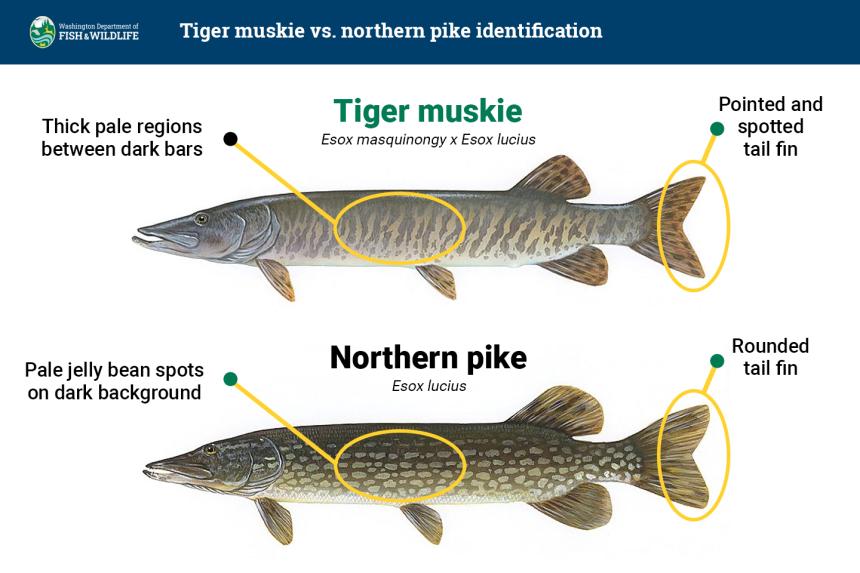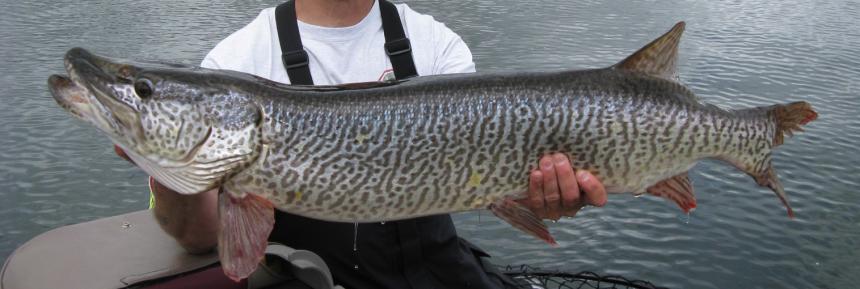Description and Range
Physical description
Tiger muskies are one of three members of the pike family living in Washington. The other two are grass pickerel and northern pike. The tiger muskie is a sterile cross between northern pike Esox lucius and muskellunge, or true muskie Esox masquinongy. All members of the pike family have the same general appearance, having a long, cylindrical-shaped body with the lobe-shaped dorsal and ventral fins far back on the body near the tail. Their head is somewhat compressed and they have a prominent duckbill-shaped snout. Tiger muskies have dark spots (juvenile) or vertical stripes/bars on a light background while northern pike have light horizontal spots on a dark background. It is the angler's responsibility to know the difference between the tiger muskie and northern pike. Tiger muskies are classified as game fish while northern pike are classified as prohibited.
Average is 18-20 inches at two years old, 25-30 inches at three years old. Mature adults are 34-48 inches and can grow to an excess of 30 pounds.
The following infographic shows ways of distinguishing invasive northern pike from sterile tiger muskie.

Where you may encounter tiger muskie
Lakes where this species may be found
How to fish for tiger muskie
Tiger muskies have earned the nickname "fish of a thousand casts", but putting in the time and effort to catch one of these trophy fish is well worth it. Adult tiger muskies are voracious predators that prefer large, soft-rayed fish like northern pikeminnow and suckers as the primary items in their diet. Because of this, successful anglers sometimes use large lures to mimic large prey that muskies prefer. Other lures such as bucktail spinners, spinnerbaits, glide baits, jerk baits, and wooden or plastic plugs work well. Some people have also used large casting spoons with some success. There is a large amount of information online about tiger muskie lures that work well in Washington.
Tiger muskies typically inhabit shallow weedy bays, near the tops of the weed beds during the warmer months from the end of May until the end of September. They can also be found hiding near or under hard structure such as logs or docks. In some lakes, these fish can also be found along underwater shelves next to steep drop-offs.
A fish this big and strong, with their fearsome teeth, does not come easily or quickly to the boat. Sturdy outfits are needed. A 7'6" fast-action, medium-heavy rod that can handle ¾ - 3oz lures is a good all-around muskie rod. For the main line, 20-30 pound monofilament or braided line works well, plus, a short length of wire, or the now-preferred fluorocarbon leader. Together, they enhance the chances of landing a large, sharp-toothed fish.
Because catch rates are low, anglers might typically fish several days during the warmer months of the year for a single strike, but they may see several "follows" daily. Often, these fish will not strike until the lure is right next to the boat so many anglers perform a "figure 8" with their lure and rod-tip in the water believing that this increases their angling success. It is also very advisable for anglers to have a very large, "knotless" landing net or cradle to land the large fish, as well as a pair of long handled pliers for removing hooks from the mouth of the fish. Caution must be taken in lifting these fish out of the water for a photo opportunity and they must be returned to the water quickly. Tiger muskies are managed as trophy opportunity with a low bag limit and a high minimum size. Always check the current regulation pamphlet for the most up-to-date regulations for the lake you plan to visit.
State record
- Weight
- 37.88 lbs
- Angler
- David Hickman
- Location
- Curlew Lake, Ferry County
- Date Caught
- July 26, 2014
